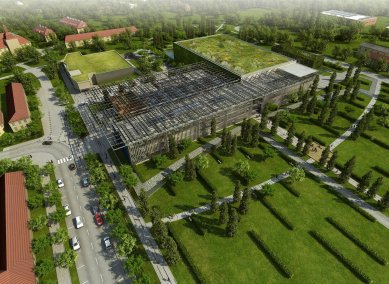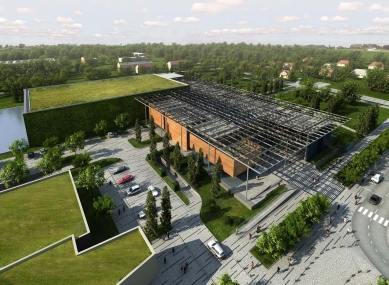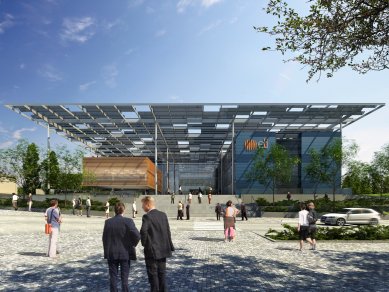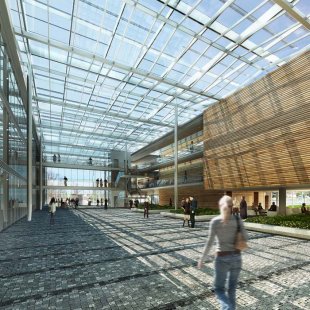
The Superlaser ELI in Dolní Břežany was designed by Bogle Architects
Source
Šárka Mrázová
Šárka Mrázová
Publisher
ČTK
05.08.2014 21:00
ČTK
05.08.2014 21:00
Czech Republic
Dolní Břežany
Ian Bogle
Bogle Architects
Dolní Břežany (near Prague) - A unique structure larger than a football field, which extends eight meters underground and 12 meters above ground, is being built in Dolní Břežany near Prague. The most modern laser center in Europe - ELI Beamlines - is expected to be fully operational here by 2018, said Michal Chudožilov, the construction coordinator for ELI, during a tour of the ELI building and its already constructed sister project HiLASE.
The center, featuring the most intense laser facility in the world, will cost 6.8 billion crowns, with most of the funding coming from European funds. It is to be a cutting-edge international research infrastructure of the new generation.
"It will be the first center designed for users, allowing them to come, conduct their research, and configure it according to their needs. And to have available the maximum number of synchronized high-power lasers," said Daniel Kramer, head of the research team, to ČTK. He returned to Prague after seven years at the prestigious Swiss center CERN to help establish ELI.
In six underground experimental spaces, the walls are about 6 meters high, 1.6 meters wide, and a massive reinforced concrete ceiling spans above them. Additional laser halls are being constructed on the above-ground floors. Builders had to dig down to the rock to create the large halls.
"This guarantees that the spaces will not vibrate. In some buildings, settling is normal, but that is not desired in these experimental spaces. We want the foundation of the building, built as it is now, to settle and not move," described Chudožilov. Labyrinths of shielding blocks made from high-density concrete are also being created around the experimental halls to ensure that any radiation from the experiments does not reach the scientists operating them. The bricks are also very heavy to ensure tightness. Approximately 35,000 cubic meters of concrete and 12,000 tons of steel have already been used for the construction, Chudožilov added.
Laser beams will travel through vacuum pipes around the building using large mirrors, with subsequent experiments conducted underground. "The unique aspect of the center is that we have a distribution system that can be automatically reconfigured into different setups. One beam is sent from one room to another, where it combines with another beam, enabling highly sophisticated experiments," explained Kramer.
According to him, ELI should be the first to achieve petawatt power at a 10Hz shot frequency. One of the lasers is already being produced at the American national laboratory LLNL. Meanwhile, another laser should be the first in the world to reach 10PW power, meaning the highest energy in the shortest time.
According to architect Viktorie Součková of Bogle Architects, the roof of the building will also be unique, allowing enough light into the building while simultaneously insulating it from sunlight. The construction must be completed by the end of 2015, according to the new project leader Roman Hvězda. This, including the development of technologies, was a condition set by the European Commission for the project to be extended by two years. Research programs are expected to start at the beginning of 2018.
ELI's laser technologies will have unique parameters in terms of pulse power, the number of installed lasers of various types, and particularly their repetition frequencies. Scientists will first explore extreme physical phenomena in the laboratories as part of basic research, such as laboratory astrophysics through simulations of events within stars. The highest possible repetition frequency of laser beams is required for these experiments. Material research and the development of electron and proton sources, which could contribute to proton therapy in cancer treatment, will also be important.
The center, featuring the most intense laser facility in the world, will cost 6.8 billion crowns, with most of the funding coming from European funds. It is to be a cutting-edge international research infrastructure of the new generation.
"It will be the first center designed for users, allowing them to come, conduct their research, and configure it according to their needs. And to have available the maximum number of synchronized high-power lasers," said Daniel Kramer, head of the research team, to ČTK. He returned to Prague after seven years at the prestigious Swiss center CERN to help establish ELI.
In six underground experimental spaces, the walls are about 6 meters high, 1.6 meters wide, and a massive reinforced concrete ceiling spans above them. Additional laser halls are being constructed on the above-ground floors. Builders had to dig down to the rock to create the large halls.
"This guarantees that the spaces will not vibrate. In some buildings, settling is normal, but that is not desired in these experimental spaces. We want the foundation of the building, built as it is now, to settle and not move," described Chudožilov. Labyrinths of shielding blocks made from high-density concrete are also being created around the experimental halls to ensure that any radiation from the experiments does not reach the scientists operating them. The bricks are also very heavy to ensure tightness. Approximately 35,000 cubic meters of concrete and 12,000 tons of steel have already been used for the construction, Chudožilov added.
Laser beams will travel through vacuum pipes around the building using large mirrors, with subsequent experiments conducted underground. "The unique aspect of the center is that we have a distribution system that can be automatically reconfigured into different setups. One beam is sent from one room to another, where it combines with another beam, enabling highly sophisticated experiments," explained Kramer.
According to him, ELI should be the first to achieve petawatt power at a 10Hz shot frequency. One of the lasers is already being produced at the American national laboratory LLNL. Meanwhile, another laser should be the first in the world to reach 10PW power, meaning the highest energy in the shortest time.
According to architect Viktorie Součková of Bogle Architects, the roof of the building will also be unique, allowing enough light into the building while simultaneously insulating it from sunlight. The construction must be completed by the end of 2015, according to the new project leader Roman Hvězda. This, including the development of technologies, was a condition set by the European Commission for the project to be extended by two years. Research programs are expected to start at the beginning of 2018.
ELI's laser technologies will have unique parameters in terms of pulse power, the number of installed lasers of various types, and particularly their repetition frequencies. Scientists will first explore extreme physical phenomena in the laboratories as part of basic research, such as laboratory astrophysics through simulations of events within stars. The highest possible repetition frequency of laser beams is required for these experiments. Material research and the development of electron and proton sources, which could contribute to proton therapy in cancer treatment, will also be important.
The English translation is powered by AI tool. Switch to Czech to view the original text source.















